Grumman F6F-3 Hellcat
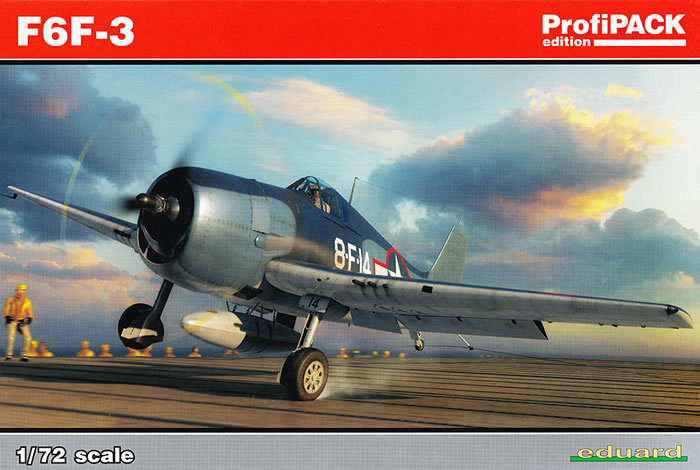
Eduard ProfiPACK, 1/72 scale
S
u m m a r y |
| Catalogue Number and Price: |
Eduard Kit No. 7074 - Grumman F6F-3 Hellcat ProfiPACK
USD$22.95 plus shipping available online from Eduard
GBP£14.20 EU Price (£11.83 Export) plus shipping available online from Hannants
|
| Scale: |
1/72 |
| Contents and Media: |
Three grey injection moulded sprues containing 186 parts, 15 clear parts on 1 clear sprue, 6 Brassin cast resin parts, 1 set of brass photoetched metal parts (11 parts), 2 sheets of decals, 20 page instruction booklet |
| Review Type: |
FirstLook (Re-Release) |
| Advantages: |
Crisp yet subtle moulding with superb detail, Eduard’s usual high quality instructions. A nice choice of schemes. |
| Disadvantages: |
|
| Conclusion: |
A great kit of the F6F-3 Hellcat from Eduard with everything included to make a highly detailed model. |
Reviewed by David Couche

The Grumman F6F Hellcat is an American carrier-based fighter aircraft of World War II. Designed to replace the earlier F4F Wildcat and to counter the Japanese Mitsubishi A6M Zero, it was the United States Navy's dominant fighter in the second half of the Pacific War. The Hellcat competed with the faster Vought F4U Corsair for that role and prevailed, as the Corsair had significant issues with carrier landings. The Corsair, instead, was primarily deployed to great effect in land-based use by the U.S. Marine Corps.
Powered by a 2,000 hp (1,500 kW) Pratt & Whitney R-2800 Double Wasp, the same powerplant used for both the Corsair and the United States Army Air Forces (USAAF) Republic P-47 Thunderbolt fighters, the F6F was an entirely new design, but it still resembled the Wildcat in many ways. Some military observers tagged the Hellcat as the "Wildcat's big brother".
The F6F made its combat debut in September 1943, and was best known for its role as a rugged, well-designed carrier fighter, which was able to outperform the A6M Zero and help secure air superiority over the Pacific theatre. A total of 12,275 were built in just over two years of which 4402 were the F6F-3 version.
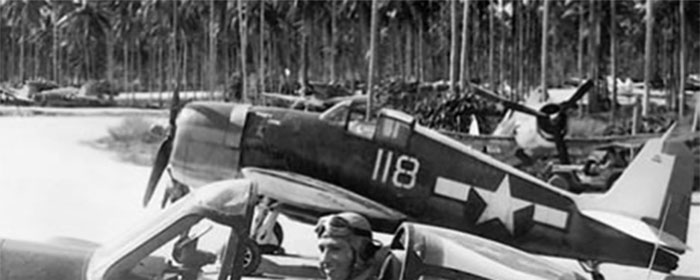
Above: A VF-34 aircraft (118) with white spine/tail on Nissan Island like Scheme C
Hellcats were credited with destroying a total of 5,223 enemy aircraft while in service with the U.S. Navy, U.S. Marine Corps, and Royal Navy Fleet Air Arm. This was more than any other Allied naval aircraft. Post-war, the Hellcat was phased out of front-line service, but remained in service as late as 1954 as a night fighter.
Eduard first released the 1/72 F6F-3 Hellcat kit in 2011. At the time it was the best and most accurate Hellcat produced. Since then it has been released in a number of different boxing’s including early the ProfiPack, over-trees and several Weekend Editions. This recent boxing basically sees the same kit in the box but first in grey plastic now which is standard in all Eduard kits and with 5 new schemes. Their release notes state with new parts, but a sprue by sprue comparison with the original shows no real change in the kit but the new plastic and new decals.
The sturdy Eduard box is packed with all the goodies you will need to make a really nicely detailed model of this Hellcat. The contents include, 3 grey injected moulded sprues with some 69 parts on them. Upon careful examination of the instructions I find that 19 of these parts are not to be used in this version, so the spares box will have more welcome additions. There is one clear sprue containing 8 very clear parts, 2 sheets of photoetch containing 62 parts, a sheet of masks and the usual comprehensive instruction booklet.
All sprues are cleanly moulded with no flash evident and sprue gates to the parts appear to have been created to minimise their effect on the parts. The surface detail is refined and very appropriate to the scale.
Sprue A
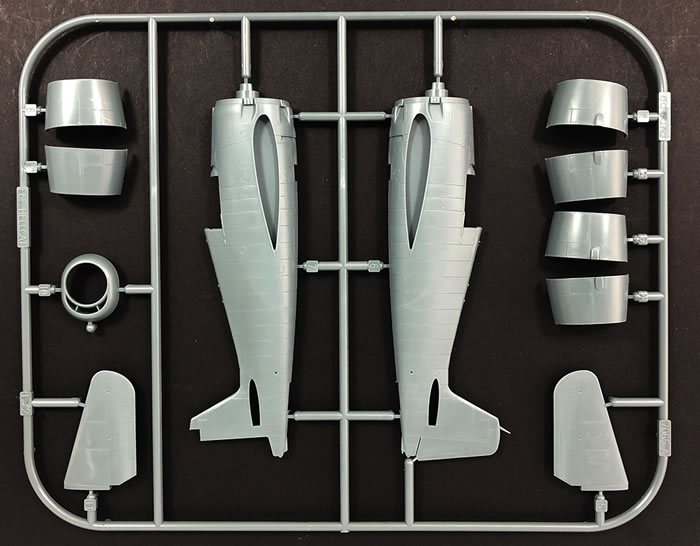
This sprue has 11 parts on it, with 2 not used for this model. This is a set of -5 version cowling parts. This sprue has the fuselage halves which have the overlap panel detailed moulded in beautifully. It also has 2 other sets of cowling panels, from which you select according to the scheme you are building. If you are going to used aftermarket decals, do your research well into the correct cowl to use. There is also a set of tailplanes on this sprue as well as the nose ring
Sprue B
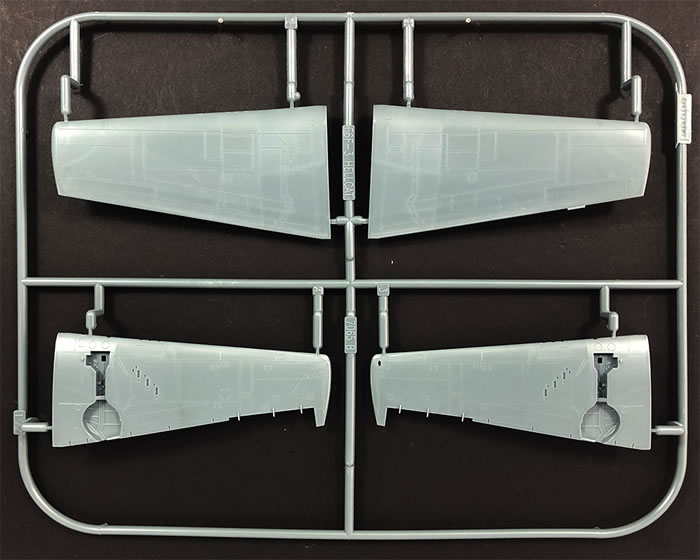
Sprue B has the upper and lower wing panels. Again, beautifully detailed and needing very little cleaning up.
Sprue D

This large sprue has 54 parts on it, with 19 of these unharmed in making the -3 version. This sprue delivers us the undercarriage components, a lovely one piece radial engine, tailwheel cockpit parts, drop tanks and a myriad of smaller parts used throughout the model. Again, all parts are nicely moulded showing little in the way of flash or bad mould seams which is good for a set of moulds that have done a great deal of work over 11 years. This sprue has a really nice set of underwing rockets which are not used here but will certainly be a valuable addition to the spares box.
Sprue E

Sprue E is the clear sprue containing 8 parts, with 3 parts (the -5 canopy parts) not used. Crystal clear and well moulded. It is a 2 part canopy so can be positioned open or closed.
Photo-Etch

There are very nice photoetch sheet of 62 parts is included in the ProfiPack which includes pre-coloured seat belts and instrument panel. There are many parts, such as the radiator, engine wiring looms, drop tank braces and many small additions to the cockpit. One puzzling thing, is that, there are several large parts on the brass sheet that are not mentioned at all in the instructions. I take it that they are not used with this build. They do seem to be individual cooling gills, so maybe for the expert modeller it’ll give you another option to spruce the kit up
Masking Sheet
A sheet of typical Eduard tape style masks completes the kit. These allow for masking of both open and closed canopies as well as masking for the wingtip, underwing and fuselage light. This is a very useful inclusion.
Instructions and Decals
The instructions for the kit are the usual Eduard, high quality detailed instructions, with copious colour call outs throughout, using the Gunze Aqueous and Mr Color range.
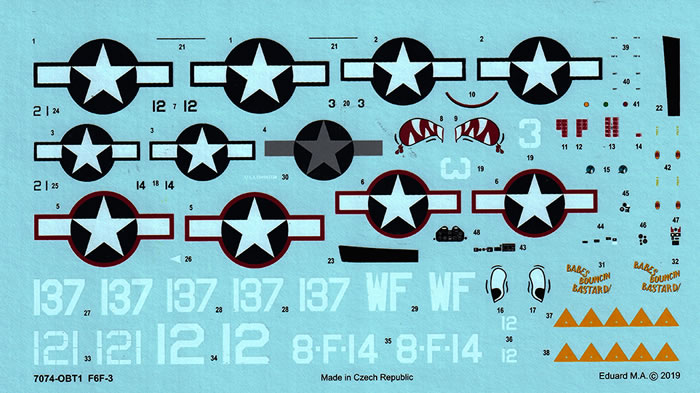
The decals appear to be in perfect register giving the options for 5 different aircraft. Included is a comprehensive stencil and data sheet, with a separate page at the end of the instructions for their placement.
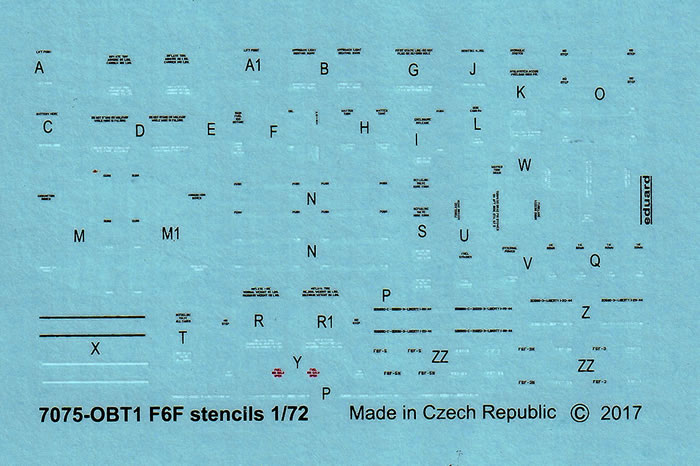
I have included a scan of the five aircraft profiles but briefly, they are;
-
F6F-3, 8-F-14, VF-8,| USS Intrepid (CV-11), June 1943
-
F6F-3, 12, VF-9 (Lt. Hamilton McWhorter), USS Essex (CV-9), March 1944
-
F6F-3, 121 “Babes Bouncing Bastard”, VF-34 (Lt. L.A. Edmonston), Nissan Island, May 1944
-
F6F-3, 3, VF-27 (ENS Gordon Arthur Stanley) - Battle of Leyte Gulf, USS Princeton (CVL-23), October 1944
-
F6F-3, WF/137, OTU VF-2, NAS Melbourne (Florida), October 1944
This is a very nice, well detailed kit. The Eduard F6F-3 kit ticks all the right boxes, a great choice of schemes covering a range of schemes used in the early period of Pacific theatre of operations. Great detail, quality moulding, added etch extras and masks… can a modeller ask for more?
Thanks to Eduard for the sample
Review Text Copyright © 2020 by David Couche
Page Created 10 March, 2020
Last updated
10 March, 2020
Back to HyperScale Main Page
Back to Reviews Page Woo! |
